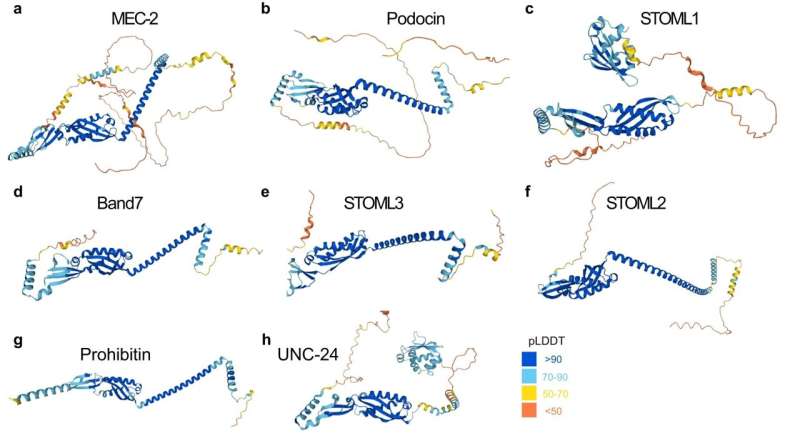This article has been reviewed according to Science X's editorial process and policies. Editors have highlighted the following attributes while ensuring the content's credibility:
fact-checked
peer-reviewed publication
trusted source
proofread
A change in rigidity switches the function of protein condensates involved in sensing touch

Touch plays a fundamental role in our physical, emotional, and social well-being. From a primary way of conveying emotions to sensory integration, it is crucial for the complex growth of cognitive, emotional, social, and behavioral abilities especially during the early development of infants and children. Touch allows us to build connections with others, eases pain and stress, and helps us to understand the world around us giving crucial information such as the texture, temperature, and shape of objects.
When sensing any stimuli, such as when the body is being touched, the mechanical signals are transformed into biological responses that help us to adapt to continuously changing environments. This transformation involves a variety of intracellular and molecular processes inside the cells that enable us to perceive and respond to tactile stimuli effectively converting the physical stimuli into electrical activity.
The ability of cells to sense and transmit mechanical forces depends on the correct assembly, localization and mechanical properties of the protein complexes in the force transmission pathway. Often, large macromolecular protein complexes form liquid-like condensates in a process akin to phase separation.
Such biomolecular condensates are found in many, if not all, eukaryotic cells, and play a vital role in various physiological and pathological processes, constituting a promising clinical target. Due to the liquid-like nature of these biomolecular condensates, their role in mechanotransduction, that is, any mechanism by which cells convert mechanical stimulus into electrochemical activity, is not clear.
Although studies have shown that their material properties can change from liquid to solid over time, there is one remaining question: Can these condensates, with different material properties, have different biological functions?
Examining MEC-2 protein condensates in touch receptor neurons
To address the question, ICFO researchers Neus Sanfeliu, Frederic Català, Iris Ruider, Montserrat Porta and Stefan Wieser, led by Prof. Michael Krieg, in collaboration with IRB Barcelona researchers Borja Mateos, Carla Garcia, Maria Ribera and Adrià Canals, led by ICREA Prof. Xavier Salvatella, published a study in Nature Cell Biology identifying the mechanism by which specific protein condensates transition from liquid to solid states, enabling the stability and transmission of the mechanical forces.
The focus of the study was the MEC-2 protein member of the Stomatin family, which is essential for the membrane mechanics and modulation of the ion channel activity. Sanfeliu and the team found that MEC-2 also forms condensates in the touch receptor neurons of the roundworm Caenorhabditis elegans, a model organism widely used for studying the structure and function of the nervous system.
The researchers created transgenic animals carrying a single copy of the MEC-2 protein marked with a fluorescent label. Combining fluorescence imaging in an inverted confocal microscope and the FRAP technique, a fluorescence microscopy method, they identified two different MEC-2 populations within the touch receptor neurons: a liquid and mobile pool, close to the cell body, that facilitates transport along the thin neurons; and a solid-like mature population in the distal neurites.
They applied mechanical stimuli to the animal's body wall using a hybrid microfluidic-pneumatic device and observed, in combination with the FRET fluorescence microscopy technique used to study molecular interactions, that only mature populations sustain mechanical forces during touch.
To analyze in detail the properties of these protein condensates, the researchers reproduced the condensation process in the test tube and performed nuclear magnetic resonance experiments, revealing the molecular mechanisms that lead to condensation and regulate the mechanical properties of the condensates. In addition, by using a technique called optical tweezer microrheology, they studied how the mechanical properties of the purified protein condensates changed over time.
Changing from fluid to solid switches the function of condensates
With the help of a neuron-specific screen, Sanfeliu and colleagues identified that another protein, UNC-89 from the Titin superfamily, was responsible for promoting MEC-2 condensates rigidity maturation in vivo. This structural transformation led to a shift in their biological function, which switched from facilitating the transport of the protein to facilitating the integration and conversion of mechanical cues during mechanosensation.
These findings describe a new biological function of the liquid-to-solid phase transition of the MEC-2 proteins. Even more, they also draw a new role, previously unidentified, for the UNC-89 proteins in the neurons.
Given the significant roles that biological condensates play in various physiological and pathological processes, a better understanding of their functions might open new possibilities for innovative therapies and treatments, such as those aimed at understanding the molecular details that drive rigidity transitions in health and disease.
"We are really excited about the role of condensate maturation in mechanotransduction," comments Prof. at ICFO Michael Krieg, "and to look for ways to investigate how defects in protein condensation play in the development of neurological disorders."
ICREA Prof. at IRB Barcelona Xavier Salvatella says, "It has been known for some time that changes in the material properties of condensates can be detrimental and lead to diseases but this work shows how they can also be functional and be regulated by protein-protein interactions. It has been great to contribute to this discovery and we look forward to continuing to work on this together with our colleagues at ICFO."
This study is an indication of the successful collaborative efforts both research groups have had in obtaining these results. As Krieg concludes, "We look forward to continue collaborating with Salvatella's research group at IRB Barcelona in the hopes of finding new amazing results that can further help us understand cell mechanical properties on the molecular and systems level, to tackle health and disease issues."
More information: Sanfeliu-Cerdán, N. et al. A MEC-2/stomatin condensate liquid-to-solid phase transition controls neuronal mechanotransduction during touch sensing, Nature Cell Biology (2023). DOI: 10.1038/s41556-023-01247-0 www.nature.com/articles/s41556-023-01247-0
Journal information: Nature Cell Biology
Provided by ICFO




















